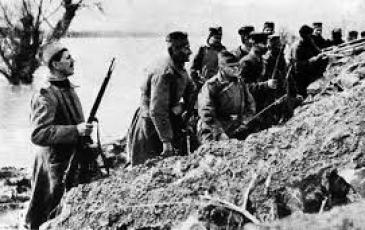1914_1203_01: The Breaking Point - FWWC 03 Serbia '14

 0 - 0 - 0
0 - 0 - 0

| Rating: | 0 (0) |
| Games Played: | 0 |
| SM: | 7 |
| Turns: | 102 |
| Type: | Stock |
| First Side: | Central Powers |
| Second Side: | Allied Powers |
Arandjelovac, Serbia, 3rd December 1914:
With the Kolubara and Ljig breached, and the strategic narrow gauge rail line between Obrenovac and Lajkovac secured with a train carrying vital supplies to the exhausted Austro-Hungarian forces, Potiorek intended to crush the Serbian Army once and for all. Both 5. and 6.Armee were ordered to continue their advance again, no rest was allowed; and just like before, only one more blow was believed required to break the enemy.
In the north, Beograd had been seized with much celebration, but the cost of its capture was that the Kombinierte Korps, one of the best Austro-Hungarian formations in the theatre, had accumulated much fatigue in the long and uneventful forced march from the Kolubara to Beograd, then back south towards Umcari.
On the Serbian side, after their defeat along the Kolubara and Ljig, they had completely withdrawn to a line that formed a right angle around the town of Arandjelovac. The Serbian Army had moved for three days to their position and left rear guards in place to harass the advancing Austro-Hungarians who were blundering forward, blinded by bad weather. After the Serbians arrived at their new position, most of the army rested for two days and were finally receiving supplies from Russian and France from Salonika. Most importantly, for the first time the Serbian Army was recovering its strength with replacements from anyone who could be scraped up, including gendarmes and new recruits, and from stragglers returning to their units as morale improved to a feeling of invincibility.
For political reasons, the Austro-Hungarian 5.Armee had postponed rest in order to sieze Beograd. By the 2nd of December, 6.Armee had reached their breaking point, out of supplies and exhausted, it was at this point that Potiorek finally agreed to a two day period of reorganization and rest, but it was too late. Sensing that the time was right, the Serbians launched their desperate counter offensive.
[Size: large]
*See the notes document for information on scenario design decisions and historical notes.
With the Kolubara and Ljig breached, and the strategic narrow gauge rail line between Obrenovac and Lajkovac secured with a train carrying vital supplies to the exhausted Austro-Hungarian forces, Potiorek intended to crush the Serbian Army once and for all. Both 5. and 6.Armee were ordered to continue their advance again, no rest was allowed; and just like before, only one more blow was believed required to break the enemy.
In the north, Beograd had been seized with much celebration, but the cost of its capture was that the Kombinierte Korps, one of the best Austro-Hungarian formations in the theatre, had accumulated much fatigue in the long and uneventful forced march from the Kolubara to Beograd, then back south towards Umcari.
On the Serbian side, after their defeat along the Kolubara and Ljig, they had completely withdrawn to a line that formed a right angle around the town of Arandjelovac. The Serbian Army had moved for three days to their position and left rear guards in place to harass the advancing Austro-Hungarians who were blundering forward, blinded by bad weather. After the Serbians arrived at their new position, most of the army rested for two days and were finally receiving supplies from Russian and France from Salonika. Most importantly, for the first time the Serbian Army was recovering its strength with replacements from anyone who could be scraped up, including gendarmes and new recruits, and from stragglers returning to their units as morale improved to a feeling of invincibility.
For political reasons, the Austro-Hungarian 5.Armee had postponed rest in order to sieze Beograd. By the 2nd of December, 6.Armee had reached their breaking point, out of supplies and exhausted, it was at this point that Potiorek finally agreed to a two day period of reorganization and rest, but it was too late. Sensing that the time was right, the Serbians launched their desperate counter offensive.
[Size: large]
*See the notes document for information on scenario design decisions and historical notes.





















